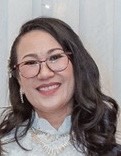I used to be a teacher in a middle school in VietNam for ten years before I moved to the United State and went to school here. I could see a big difference in teaching method between the two countries. In this country, teachers can often set up their own timing for their classes and choose any state standard textbook which they think suitable for their students. In contrary, in Viet Nam, I and my colleague were asked to teach exactly as provided in the textbook and time-framework that was used for the whole country. We had a hard time building lesson plans to teach for all level students, especially in the countryside, where students were often at a lower level. We didn’t have co-teachers, and classes were big (30-40 students per class). We had no technology in classes (one projector for the whole school). We just told students what lesson they need to learn and showed them how problems could be solved. Students just followed what steps they learned. Therefore, the teaching method we used was “teacher centered”. We did not have much help for higher or lower level students.
I had some difficulty understanding what this new "student centered" teaching method is: a collection of textbooks or guides, a set of content standards that teachers must cover, and a program of study that must be completed before the end of the school year? This question was a big challenge to me.
I have learned in education courses at Westfield State University about what we should do to become a successful teacher. I knew “student centered” is a new teaching method. But although I had some experience from my pre-practice courses at some middle or high school around here, I have never been confident on using “student centered teaching” in class activities until I took this “Exploring the Mathematical Knowledge of Teaching” class.
In this course, we met once a week at school to fill out our gap of knowledge and method of teaching. Another day of every week, we took turns to practice teaching or co-teaching at Westfield High school. The wonderful thing here is that we could design our own lesson plans and teach them in our ways that we learned from this course. We also teach them why, not just how to solve problems. Our teaching methods and practices reflected democratic processes rather than authoritarian styles. Teachers just lead debates, dialogue, and conversations that require group and individual work. All these techniques responded to individual needs and taught the individual to work in groups, to listen to others, and to explain his or her point of view.
Since students have different level math skills in a class, we provided resources at a range of practicing math levels and at varying degrees of content complexity so that all students have access to materials that are appropriately challenging for their needs. We use a variety of techniques such as Think-Pair-Share and random calling on students to ensure that everyone has the opportunity and expectation to contribute to class understanding.
Now the definition of “student centered” is clearer to me. It is based on the idea what students are expected to know, understand and be able to do in each subject and grade. Teachers have the flexibility to determine “how” students achieve the expected learning outcomes to bring the curriculum to life in the classroom through meaningful learning activities. I feel more confident in this method of teaching since I could see how much students improved after spending one class period every week with them for three months. My students understood the concepts, and solved problems on their own.
As a teacher of mathematics in the future, my next challenge is doing well on using good questions when I teach. Though I have learned how to use good questions in teaching, I still have not enough experience to do this well. I know that if my students do not understand or answer for what I ask of them, I am not a successful teacher. Therefore, I have to learn more types of questions and practice using them in the right situations in classes to help my students’ understanding and help them make sense of mathematical ideas.

